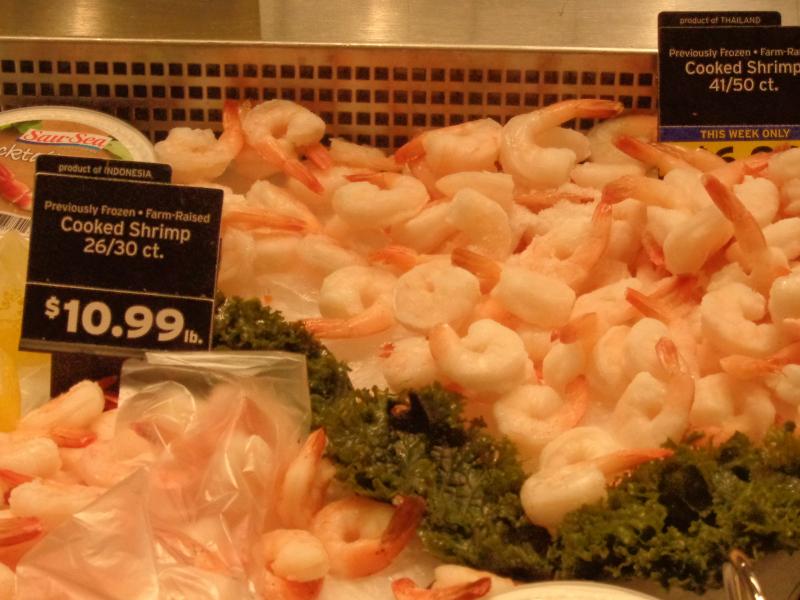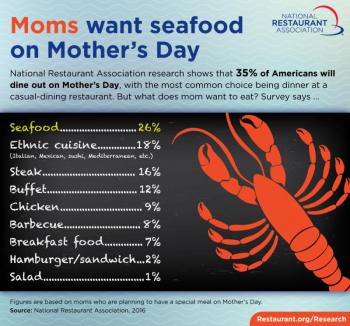Tuesday, May 10, is National Shrimp Day, though the origins of this particular designation remain a mystery.
Regarding seafood in general, U.S. citizens are big fans. We consumed enough from 2007-2009 to outseat Japan as the second largest seafood consumer in the world, according to the National Marine Fisheries Service. China, at that time, was number one.
Our favoritism toward ocean protein is evident in a pre-Mother's Day 2016 poll by the National Restaurant Association, which asked mothers what their desired special meal included.
Twenty-six percent of mothers preferred seafood. This is opposed to 18 percent who wanted Italian, Mexican, sushi or Mediterranean; 16 percent who wanted steak; and 12 percent who wanted a variety of food from a buffet. Chicken, barbecue, breakfast, hamburger/sandwiches, and salad all had single digit percentages.
Of the marine options, per capita consumption of shrimp in the U.S. rose from 1.7 in 1983 to 4.2 in 2011, according to the NMFS.
Where this shrimp comes from is interesting.
In the April to December 2013 fishing season, the U.S. became the largest purchaser of Indian shrimp. This is due in part to a lowering of the countervailing duty on Indian shrimp in the U.S., as well as a disease called Early Mortality Syndrome that seriously affected production in the U.S.'s other markets — Southeast Asia, Thailand, Vietnam, and Malaysia.
According to the Marine Products Export Development Authority, the Indian government department on seafood, the U.S. imported 51 percent of the Indian shrimp market in 2013. Sixteen percent of the remaining supply went to southeast Asia, 16 percent to the European Union and five percent to Japan.
During the financial year 2014-15, exports of Indian marine products reached an all-time high of USD $5511.12 million. Marine product exports crossed all previous records in quantity, rupee value and USD terms, according to MPEDA.
Meanwhile, a May 6, 2016 article in Seafoodnews.com reported an immediate halt to the West Coast pink shrimp fishery off the coast of Oregon. The fishery, which was already delayed three weeks because of price disputes, halted indefinitely after observations of abundant under-sized shrimp in the nets.
Maine shrimp, considered by some to be the sweetest in the world, have been off limits to shrimpers for a few years, as the government responds to the stock’s depletion. The Atlantic States Marine Fisheries Commission’s Northern Shrimp Section extended the moratorium on commercial fishing for the 2016 fishing season. The 2015 Stock Status Report for Gulf of Maine (GOM) Northern Shrimp indicates abundance and biomass indices for 2012‐2015 were the lowest on record for the 32‐year time series.
Fishable biomass from 2012‐2015 was the lowest on record, according to commission data. Recruitment of northern shrimp is related to both spawning biomass and ocean temperatures, with higher spawning biomass and colder temperatures producing stronger recruitment. Ocean temperatures in western GOM shrimp habitat have increased over the past decade and reached unprecedented highs in 2011 and 2012. While 2014 and 2015 temperatures were cooler, temperatures are predicted to continue to rise as a result of climate change, the commission said.
“This suggests an increasingly inhospitable environment for northern shrimp,” the commission said, in a December press release. “The Northern Shrimp Technical Committee considers the stock to have collapsed with little prospect of recovery in the immediate future.”
And the Gulf of Mexico, once the top national harvester of shrimp? Well, We’ll just see if the runoff from erosion and pesticides continues to threaten that shrimping industry.
But, alas. Grab a (shrimp) appetizer. Raise a cocktail (sauce). Today is National Shrimp Day.
Sarah Thompson can be reached at news@penbaypilot.com.


























